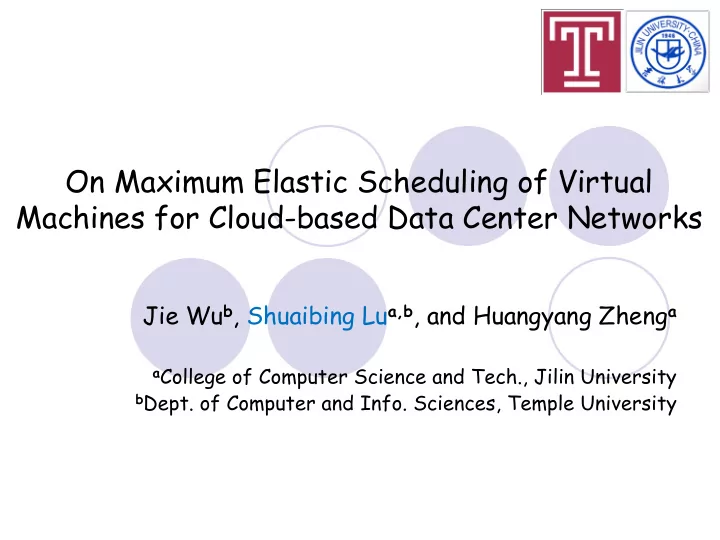

On Maximum Elastic Scheduling of Virtual Machines for Cloud-based Data Center Networks Jie Wu b , Shuaibing Lu a,b , and Huangyang Zheng a a College of Computer Science and Tech., Jilin University b Dept. of Computer and Info. Sciences, Temple University
Outline 1. Background 2. Model and Formulation 3. Simple and Optimal Solutions 4. Properties 5. Simulation Comparisons 6. Conclusions
1. Background q Cloud Data Center Networks (DCNs) ● Supporting cloud-based applications for large enterprises q Virtual Machine Placement ● Solving the resource utilization problem in a cloud DCN q Motivation ● Allocating physical machines (PMs) to virtual machines (VMs) ● Meeting computation and communication demands ● Avoiding load redistribution during a run time
Hose Model Each hose has aggregated performance guarantees instead of pairwise performance guarantees [1] . A A 2 C C 3 B B pairwise hose [1]. Duffield, Nick G., et al. "A flexible model for resource management in virtual private networks." ACM SIGCOMM Computer Communication Review. Vol. 29. No. 4. ACM, 1999.
Hose-based Elastic Scheduling What is the maximum total occupancy limit and the actual assignment at each house so that cable lines can support the bandwidth of all possible simultaneous pairwise telephone conversations and maximum elasticity ? 100% 100% link 50% 50% 100% 100% VM PM
2. Model and Formulation q Problem ● Provisioning the maximum admissible load (MAL) of VMs in PMs with tree-structured DCNs using the hose model. q Maximum Elastic Scheduling ● A task assignment scheme that supports maximum uniform growth in both computation and communication without resorting to task reassignment.
3. A Simple Up-Down Solution MAL Up: 3-node block as a unit !"# $ % , ' % Down: Given a load < MAL at root Left !"# $ % , ' % /$ Right !"# $ ) , ' ) /$ The simple solution uses n steps, where n is the number of leaf nodes
Why Simple Solution may Fail? A Simple Solution 8+6 However How to find the OPT Solution? 16 14 > 10+6
How to Calculate? Hose-model-based orientation Link orientation is important ● min{L,R} where L + R is a constant ● 50% 50%
An Optimal Distributed Solution Insights Apply the simple solution to different orientations ● Select the best orientation ● MAL at the MAL at the MAL at the left leaf node right leaf node center node
Optimal Solution: Details q Step 1( leaf node) ● Send its load to the connected internal node leaf node ● Calculate its MAL: !"# $, ∞ + !"#{$ ) , * ) } q Step 2 (internal node with two branches) tree root ● Send virtual load !"#{$ " , * " } to the other branch ● Calculate its MAL: !"# $ ) , * ) + !"#{$ , , * , } q Step 3 (internal node with three branches) internal node ● Send !"# $ " , * " + !"#{$ - , * - } to the third branch ● Calculate its MAL: !"# $ ) , * ) + !"# $ , , * , + !"#{$ . , * . }
Optimal Solution: Example An example 4+6+6
4. Properties Theorem 1: The optimal solution determines the MAL. Theorem 2: Hierarchical load distribution generates a schedule with maximum elasticity. Theorem 3: The optimal solution uses 2logn+1 steps. The computation complexity is 5(n − 1), and the communication complexity is 4(n − 1) . Theorem 4: The simple solution is optimal for a fat-tree.
5. Simulation Comparisons q Basic Setting ● A strict binary tree with levels k = 4 , 5 , and 6 ● Heterogeneous node space from 0 to 100 units ● Bandwidth demand per-pair of VMs is 1 Gbps Three Comparison algorithms Equally Distributed Placement (EDP) ● Proportion with PM Capacities (PPMC) ● Proportion with Physical Link (PL) Capacities (PPLC) ● Proportion with Physical Combinational Capacities (PPCC) ●
Experiments Comparison of the elasticities ● simple and optimal solutions (a) k = 4 (b) k = 5 (c) k = 6
Experiments (cont’d) Comparison of the elasticities ● Three comparison algorithms and PPCC (a) k = 4 (b) k = 5 (c) k = 6
6. Conclusions q Objective of maximum communication elasticity q Hose model q Maximum elastic scheduling (distributed, optimal solution) q Maximum admissible load (MAL) q Maximum elastic scheduling of admissible load q Experiments q Efficiency and effectiveness
Q&A Publication: 143 Journal’s Aims and Scope: Page view: System architecture, operating Ø systems and network hardware for 2015 (43,034) sensor and actuator networks 2016 (62,526) Communication and network Ø 2017 (160,876) protocols 2018 (77,310) Data processing, data storage and Ø Editor-in-Chief data management within sensor and Prof. Dr. Dharma P. Agrawal actuator networks University of Cincinnati, Cincinnati, Programming models and OH 45221-0030, USA Ø middleware for sensor/actuator Founding Editor-in-Chief networks Prof. Dr. Stefan Fischer Embedded systems Ø Director of Institute of Telematics, Security and privacy Ø University of Luebeck, Lübeck 23562, Germany
Recommend
More recommend